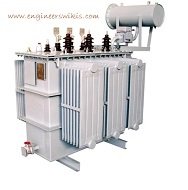
Transformer testing is crucial to ensure the reliable and safe operation of transformers in electrical power systems. These tests are performed to assess the transformer’s performance, insulation integrity, and overall health. Here are some common transformer testing procedures:
- Transformer Turns Ratio Test: This test verifies the turns ratio of the transformer by applying a known voltage to the primary winding and measuring the resulting voltage on the secondary winding. The measured ratio is compared with the transformer’s nameplate ratio to ensure accuracy.
- Transformer Polarity Test: The polarity test determines the relative phase relationship between the primary and secondary windings. It ensures that the transformer’s polarity markings match the intended direction of current flow.
- Transformer Winding Resistance Test: The winding resistance test measures the DC resistance of the transformer windings. It helps identify any high-resistance connections or faulty windings that could cause excessive power loss or overheating.
- Transformer Insulation Resistance Test: This test assesses the insulation resistance between the transformer windings and the transformer tank or core. A high-voltage DC source is applied, and the insulation resistance is measured to ensure the integrity of the transformer’s insulation.
- Transformer Megger Test: The Megger test evaluates the insulation resistance of the transformer at a higher voltage than the insulation resistance test. It helps detect any insulation degradation or leakage paths that may compromise the transformer’s performance.
- Transformer Oil Testing: Transformer oil analysis is performed to assess the condition of the insulating oil. Tests may include dissolved gas analysis (DGA), moisture content, acidity, dielectric breakdown voltage, and other parameters. These tests provide insights into the transformer’s internal condition, presence of contaminants, and potential insulation issues.
- Transformer Power Factor Test: The power factor test measures the power loss and efficiency of the transformer. It involves applying a test voltage to the transformer and measuring the current phase angle to determine the power factor. The test helps identify any losses or inefficiencies in the transformer.
- Transformer Impedance Test: The impedance test measures the transformer’s impedance, which is the ratio of the voltage drop across the transformer to the current flowing through it. This test helps assess the transformer’s ability to limit short-circuit currents and provides important information for protection coordination.
- Transformer Short-Circuit Test: The short-circuit test is conducted to determine the transformer’s impedance and losses under short-circuit conditions. It involves applying a reduced voltage to the primary winding while keeping the secondary winding shorted. The test helps validate the transformer’s thermal and electrical ratings.
- Transformer Partial Discharge Test: The partial discharge test detects any partial discharge activity within the transformer insulation. It helps identify potential insulation weaknesses or faults that could lead to insulation breakdown and failure.
- Transformer Insulation Power Factor Test: The insulation power factor test, also known as the dissipation factor test, evaluates the dielectric losses in the transformer insulation system. It measures the power factor angle between the applied voltage and the resulting current. The test helps assess the condition of the insulation and identify any issues such as moisture ingress, aging, or contamination.
- Transformer Sweep Frequency Response Analysis (SFRA): SFRA is a diagnostic test that measures and analyzes the frequency response of a transformer over a wide range of frequencies. It detects any mechanical or electrical changes in the transformer’s winding structure, such as winding movement, shorted turns, or deformation. SFRA provides valuable information for assessing transformer condition and detecting potential faults.
- Transformer Frequency Response Analysis (FRA): FRA is a specialized test that evaluates the frequency response of a transformer by injecting a low-level test signal and analyzing the resulting frequency spectrum. It is particularly useful for detecting winding deformation, core problems, and other internal faults that can affect transformer performance.
- Transformer Sweep Frequency Response Analysis (SFRA): SFRA is a diagnostic test that measures and analyzes the frequency response of a transformer over a wide range of frequencies. It detects any mechanical or electrical changes in the transformer’s winding structure, such as winding movement, shorted turns, or deformation. SFRA provides valuable information for assessing transformer condition and detecting potential faults.
- Transformer Insulation Resistance Polarization Index (PI) Test: The PI test is a long-duration insulation resistance test that helps assess the insulation condition of a transformer. It involves measuring the insulation resistance at regular time intervals (typically 10 minutes and 1 minute) and calculating the polarization index (the ratio of the 10-minute resistance to the 1-minute resistance). A high PI value indicates good insulation condition, while a low value suggests potential insulation degradation or moisture ingress.
- Transformer Short-Circuit Impedance Measurement: This test determines the transformer’s impedance and reactance values under short-circuit conditions. It helps in verifying the transformer’s impedance values for protective relay coordination, fault calculations, and system stability analysis.
- Transformer Dynamic Resistance Test: The dynamic resistance test measures the transformer winding resistance during dynamic events, such as short-circuit faults or load switching. By monitoring the resistance changes, this test helps detect any abnormalities or changes in the transformer’s winding condition.
- Transformer Temperature Rise Test: The temperature rise test determines the temperature rise of the transformer under full-load conditions. It involves applying a rated load to the transformer and measuring the temperature rise of various components, such as windings, oil, and core. This test ensures that the transformer operates within safe temperature limits and verifies its thermal performance.
- Transformer Life Expectancy Assessment: Life expectancy assessment involves analyzing the transformer’s overall condition, including its age, maintenance history, test results, and operating conditions. This assessment helps estimate the remaining useful life of the transformer and assists in making informed decisions regarding maintenance, refurbishment, or replacement.
These tests and assessments provide valuable insights into the condition, performance, and health of transformers. They help identify potential issues, mitigate risks, and optimize the operation of transformers. It is important to consult relevant standards, guidelines, and the transformer manufacturer’s recommendations when conducting these tests, and to involve qualified professionals with expertise in transformer testing and diagnostics.
